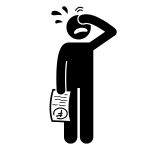Practical test vehicle safety questions
During your car practical test you’ll be asked 2 vehicle safety questions. The examiner will ask you one “tell me” question (where you explain how you’d carry out a task) before you start driving and one “show me” question (where you show how you’d carry out a task) while you’re driving. In Drive Croydon we practise those tasks with you so you are comfortable with them during the test and you can demonstrate your knowledge confidently.
Are you preparing for your driving test? The DVSA has released an official video explaining questions asked during the car driving test in the UK. It’s a great way to understand what to expect on the day of your practical driving test.
At Drive Croydon, we believe that watching a video is just the first step – the real key to passing your test is practical experience with an instructor. During our lessons in Drive Croydon, you’ll not only learn the theory but also practice every situation you might face on your test day.

— Sylwia Wisniewska, Driving Instructor at Drive Croydon
In Drive Croydon we recommend to watch official DVSA video to understand key
'Show me, tell me': tell me questions 2025: official DVSA guide
‘Show me, tell me’ — 2025
At Drive Croydon we’ll help you master the DVSA safety questions. One “tell me” question at the start, and one “show me” while driving.
Tell me questions (start of the test)
1. Tell me how you’d check that the brakes are working before starting a journey.
Brakes should not feel spongy or slack. Test them as you set off and the vehicle should not pull to one side.
2. Tell me where you’d find the information for the recommended tyre pressures for this car and how tyre pressures should be checked.
Use the manufacturer’s guide or door-frame sticker. Check with a reliable pressure gauge when tyres are cold, adjust as needed, don’t forget the spare, and refit valve caps.
3. Tell me how you make sure your head restraint is correctly adjusted so it provides the best protection in the event of a crash.
Set the rigid part at least level with your eyes or the top of your ears and as close to the back of your head as comfortable. Note: some restraints may not be adjustable.
4. Tell me how you’d check the tyres to ensure they have sufficient tread depth and that their general condition is safe to use on the road.
No cuts or bulges. At least 1.6 mm of tread across the central three-quarters of the breadth and around the entire circumference.
5. Tell me how you’d check that the headlights and tail lights are working. You don’t need to exit the vehicle.
Operate the light switch (ignition if necessary), then explain you would walk around the vehicle to check — as this is a “tell me”, you do not need to physically check now.
6. Tell me how you’d know if there was a problem with your anti-lock braking system (ABS).
The ABS warning light should illuminate if there is a fault.
7. Tell me how you’d check the direction indicators are working. You don’t need to exit the vehicle.
Operate the indicators or hazards (ignition if necessary), then explain you would walk around the vehicle to check all flashers.
8. Tell me how you’d check the brake lights are working on this car.
Press the brake pedal and use reflections in windows/doors, or ask someone to help confirm the lights are on.
9. Tell me how you’d check the power-assisted steering is working before starting a journey.
If the steering feels heavy, the system may not be working properly. Two simple checks:
- Maintain gentle pressure on the wheel while starting the engine — you should feel a slight movement as assistance begins.
- Alternatively, turning the wheel just after moving off should immediately feel light with assistance.
10. Tell me how you’d switch on the rear fog light(s) and explain when you’d use them.
Operate the fog-light switch (with dipped headlights and ignition if necessary) and check the warning light. Use when visibility is seriously reduced (typically < 100 m).
11. Tell me how you switch your headlights from dipped to main beam and how you’d know main beam is on.
Operate the main-beam control (ignition/engine if necessary) and point out the blue main-beam warning light.
12. Open the bonnet and tell me how you’d check that the engine has sufficient oil.
Identify the dipstick/oil level indicator and describe checking that the level is between the minimum and maximum markers (on level ground).
13. Open the bonnet and tell me how you’d check that the engine has sufficient engine coolant.
Identify the header tank (or radiator filler). Check against high/low marks and top up to the correct level when the engine is cool.
14. Open the bonnet and tell me how you’d check that you have a safe level of hydraulic brake fluid.
Identify the brake-fluid reservoir and check the level against the high and low markings.
Show me questions (while driving)
- Show me how you wash and clean the rear windscreen.
- Show me how you wash and clean the front windscreen.
- Show me how you’d switch on your dipped headlights.
- Show me how you’d set the rear demister.
- Show me how you’d operate the horn.
- Show me how you’d demist the front windscreen.
- Show me how you’d open and close the side window.
Ready to book?
Click the button below and complete a short form — we’ll get back to you with available lesson times.
Book Now

